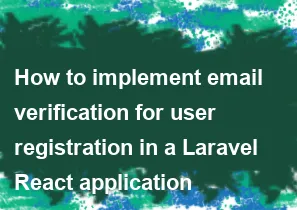How to implement email verification for user registration in a Laravel React application

Implementing email verification for user registration in a Laravel React application involves several steps. Below is a step-by-step guide to help you set up email verification:
Laravel Backend:
1. Install Laravel:
Make sure you have Laravel installed. If not, you can install it using Composer:
bashcomposer create-project --prefer-dist laravel/laravel your-project-name
2. Set up Database:
Configure your database settings in the .env file.
3. User Authentication:
Use Laravel's built-in authentication scaffolding to set up user registration and login:
bashphp artisan make:auth
4. Migration:
Run the migration to create the necessary tables:
bashphp artisan migrate
5. Generate User Model:
bashphp artisan make:model User
6. Modify User Model:
In the User model, implement the MustVerifyEmail interface:
phpuse Illuminate\Contracts\Auth\MustVerifyEmail;
use Illuminate\Foundation\Auth\User as Authenticatable;
use Illuminate\Notifications\Notifiable;
class User extends Authenticatable implements MustVerifyEmail
{
use Notifiable;
// ...
}
7. Email Verification Routes:
In the routes/web.php file, enable email verification routes:
phpAuth::routes(['verify' => true]);
React Frontend:
8. Install Laravel Sanctum:
If you haven't already, install Laravel Sanctum for API authentication:
bashcomposer require laravel/sanctum
9. Configure Sanctum:
Follow the Laravel Sanctum documentation to configure it properly: Laravel Sanctum Documentation
10. Implement Registration API:
Create an API route and controller for user registration. In the controller, send a verification email after registering the user.
11. React Frontend:
Integrate React with your Laravel application using Laravel Mix or any other method.
12. Registration Form:
Create a registration form in React that sends a request to your Laravel API for user registration.
13. Display Verification Notice:
In your React components, display a notice to the user to check their email for verification after successful registration.
Testing:
14. Verify Email:
When the user clicks the verification link in their email, Laravel will automatically verify the email.
Conclusion:
This is a basic guide, and you may need to refer to Laravel and React documentation for more detailed information. Make sure to secure your application, handle errors, and consider additional features like password reset functionalities.
-
Popular Post
- How to optimize for Google's About This Result feature for local businesses
- How to implement multi-language support in an Express.js application
- How to handle and optimize for changes in mobile search behavior
- How to handle CORS in a Node.js application
- How to use Vue.js with a UI framework (e.g., Vuetify, Element UI)
- How to configure Laravel Telescope for monitoring and profiling API requests
- How to create a command-line tool using the Commander.js library in Node.js
- How to implement code splitting in a React.js application
- How to use the AWS SDK for Node.js to interact with various AWS services
- How to use the Node.js Stream API for efficient data processing
- How to implement a cookie parser middleware in Node.js
- How to implement WebSockets for real-time communication in React
-
Latest Post
- How to implement a dynamic form with dynamic field styling based on user input in Next.js
- How to create a custom hook for handling user interactions with the browser's device motion in Next.js
- How to create a custom hook for handling user interactions with the browser's battery status in Next.js
- How to implement a dynamic form with dynamic field visibility based on user input in Next.js
- How to implement a dynamic form with real-time collaboration features in Next.js
- How to create a custom hook for handling user interactions with the browser's media devices in Next.js
- How to use the useSWRInfinite hook for paginating data with a custom loading indicator in Next.js
- How to create a custom hook for handling user interactions with the browser's network status in Next.js
- How to create a custom hook for handling user interactions with the browser's location in Next.js
- How to implement a dynamic form with multi-language support in Next.js
- How to create a custom hook for handling user interactions with the browser's ambient light sensor in Next.js
- How to use the useHover hook for creating interactive image zoom effects in Next.js